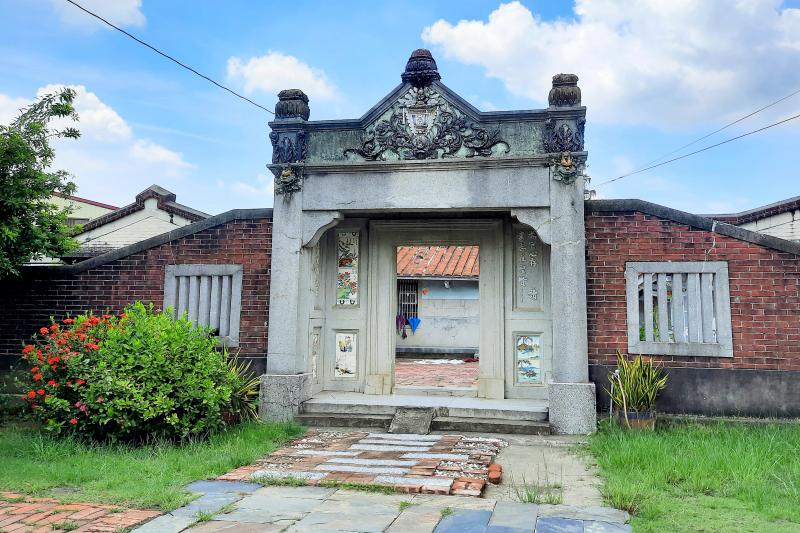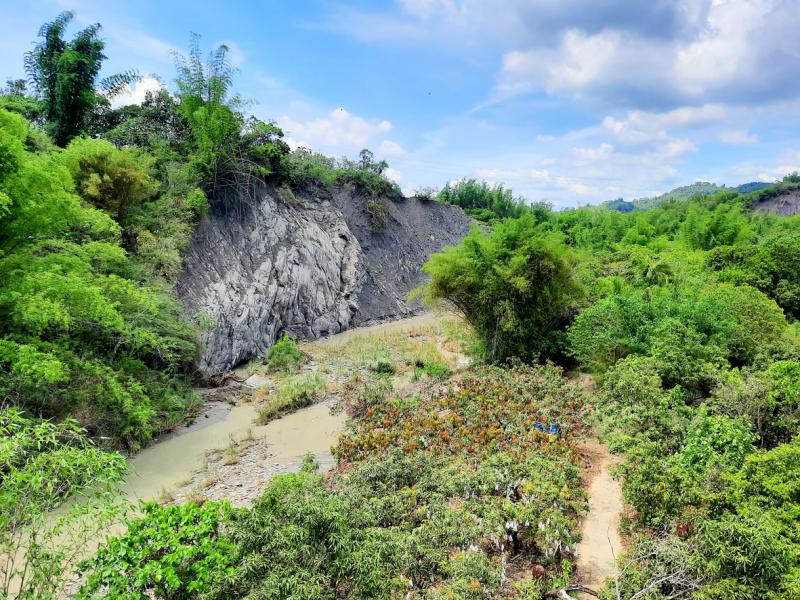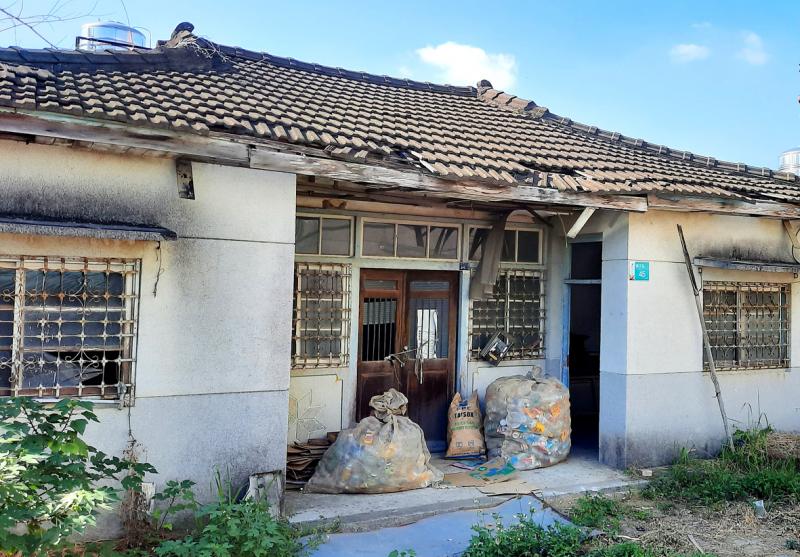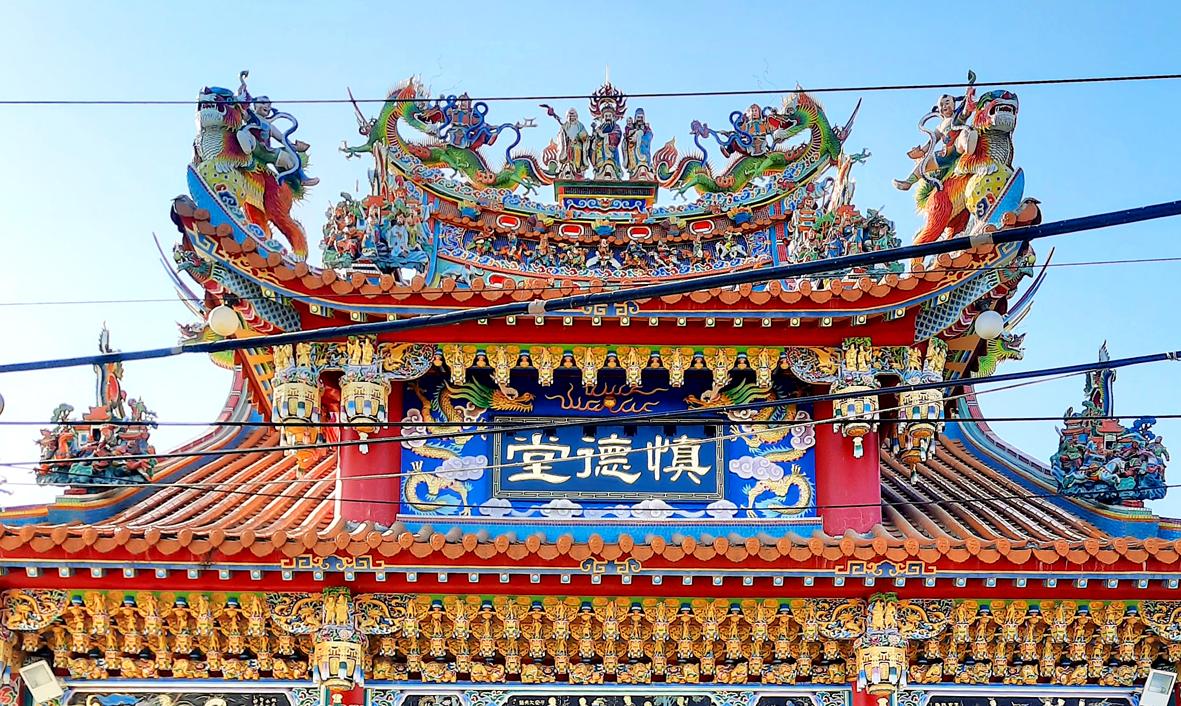Returning to Ciliwa (唭哩瓦) a couple of weeks ago, it took me a few minutes to get my bearings.
This time, I’d approached by a different route. It bypassed the village’s so-called “new community” (新社) and brought me direct to the “old community” (舊社).
Outsiders won’t notice many differences between these two settlements in an inland and ruggedly hilly corner of Tainan. Both are a mix of traditional single-story homes and more recent reinforced concrete structures. In the “newer” part of the village as in the “older,” several houses are empty, and it’s obvious nobody is trying to maintain them.

Photo: By Steven Crook
The “old community” doesn’t have a single shop, yet at its heart there’s a sizable hall of worship.
Considering how few people live in the area, Shende Temple (慎德堂) looks surprisingly new and well-funded. Does it enjoy the support of Ciliwa natives who have prospered elsewhere? A quick look at a list of donors engraved on a wall panel inside suggests that question should be answered in the affirmative.
I first visited Ciliwa more than two decades ago. It’s where my mother-in-law grew up. This spring, we drove there to reacquaint ourselves with the place

Photo: By Steven Crook
On arriving, I told my son that, if he has any indigenous blood, it’s most likely from here. Ciliwa is part of Danei District (大內), where Pingpu Austronesian culture never completely disappeared, despite gradual assimilation during the Qing, Japanese and postwar eras.
THE TAIVOAN AND SIRAYA
Danei was originally the territory of the Taivoan people (大滿族, sometimes spelled Tevorangh). The language they spoke is thought to have been closely related to those spoken by the neighboring Siraya (西拉雅族) and Makatao communities (馬卡道族).

Photo: By Steven Crook
At some point in the 17th or 18th centuries, the Siraya pushed the Taivoan deeper into the hills. The intruders established the community now known as Toushe (頭社), 4.5km northwest of Ciliwa as the crow flies. Toushe, which is renowned for its pineapples and pomelos, is one of a handful of places where Siraya night-sacrifice rituals are still held.
Even where Pingpu customs survive, the influence of Han popular religion is evident. The Pingpu of old used water as a medium to communicate with their ancestors and gods, whereas Han people use incense. Nowadays, outside surviving (or reconstructed) Pingpu worship halls, one often finds Han censers.
According to a 1636 Dutch East India Company report, the Taivoan were much thinner than the Siraya. The former also had unusually long earlobes, which they pierced. Unlike Sirayan couples, Taivoan husbands and wives lived together.

Photo: By Steven Crook
Back in the spring, my mother-in-law pointed out a vacant plot of land less than 50m from Shende Temple. In her childhood, there’d been a school there. Nowadays, kids in Ciliwa have to commute 4km to Ersi Elementary School (二溪國小).
Between the temple and the school site, there’s an abandoned single-story house unlike any other in the village. Its central position, tiled roof, gray concrete walls and symmetrical design led me to guess it was a public building. By the look of it, I’d say it dates from sometime between 1930 and 1960. Perhaps it functioned as a police outpost or a public health office.
Peering into one of the front rooms, I saw a simple bamboo palanquin of the type used in religious parades. It was covered in a thick layer of dust.
My second and more recent visit to Ciliwa was part of a long bicycle ride. I’d come via Shanshang District (山上) and pedaled across Danei Bridge (大內橋), which spans the Tsengwen River (曾文溪).
During the wet season, that river becomes an impressive torrent. In the dryer months, however, it’s not much of a barrier. It’s said that, some decades ago, boys attending Danei Junior High School — a short distance from the river’s east bank — were in the habit of wading or swimming across the Tsengwen River so they could ambush Shanshang Junior High School students. Juvenile delinquents today lack the toughness and tenacity of previous generations.
FARMER’S ASSOCIATION
Not far from the school, near the confluence of local roads 181 and 182, I stopped opposite Danei Farmers Association (大內區農會) and took a few photos of the building that houses the association’s marketing department.
This little gem dates from the final decade of the 1895-1945 period of Japanese colonial rule. To the left of the entrance, there’s a pedestal, but the statue is long gone.
I assumed the statue was of a Japanese official, and had been destroyed after World War II. In fact it honored a member of the local gentry surnamed Yang (楊), who’d played a key role in setting up the farmers association. It was removed in the 1960s, when different factions were fighting for control of the association.
Once I’d figured out which direction I should head in, I didn’t linger in Ciliwa. I wasn’t sure how long it would take me to get where I wanted to go — or even if it would be possible.
Both mapping apps on my smartphone showed a route from Ciliwa to the back of Tsoumalai Farm (走馬瀨農場), a 120-hectare leisure facility operated by Taiwan Sugar Corporation (台糖, TSC). I knew from experience, however, that such maps aren’t always accurate.
I pushed on — literally, at times. The road wasn’t too bad. The issue was gradient. The road went down, then up, then downhill so steeply I didn’t dare freewheel. Passing mango orchards and thickets of green bamboo, I reached the back of the TSC property.
There was a very low barrier, the kind designed to stop four-wheeled traffic, and it was open. Had it been closed, I’d have lifted my bike over it. If my life had depended on it, I’d have gotten a motorcycle over it.
Knowing that level 3 counter-pandemic restrictions mean the farm is closed to outsiders, I skirted the property and came to Expressway 84.
As far as I know, the easternmost section of this high-speed road is the only stretch of expressway in the country where bicycles and low-powered motorcycles are permitted.
I considered cycling northwest to Wutou (嗚頭). At the heart of that village, the Cheng Family Old Residence (鄭家古厝) is a splendid example of 1920s architecture. It’s at no. 49 Huanhu (環湖), but not open to the public.
However, there are only so many hills I can tackle in one day. I joined the cars and trucks racing along Expressway 84, and looked forward to amenities and sophistication of Yujing (玉井).
Steven Crook has been writing about travel, culture and business in Taiwan since 1996. He is the author of Taiwan: The Bradt Travel Guide and co-author of A Culinary History of Taipei: Beyond Pork and Ponlai.

Last week saw the appearance of another odious screed full of lies from the People’s Republic of China (PRC) Ambassador to Australia, Xiao Qian (肖千), in the Financial Review, a major Australian paper. Xiao’s piece was presented without challenge or caveat. His “Seven truths on why Taiwan always will be China’s” presented a “greatest hits” of the litany of PRC falsehoods. This includes: Taiwan’s indigenous peoples were descended from the people of China 30,000 years ago; a “Chinese” imperial government administrated Taiwan in the 14th century; Koxinga, also known as Cheng Cheng-kung (鄭成功), “recovered” Taiwan for China; the Qing owned

In Taiwan’s politics the party chair is an extremely influential position. Typically this person is the presumed presidential candidate or serving president. In the last presidential election, two of the three candidates were also leaders of their party. Only one party chair race had been planned for this year, but with the Jan. 1 resignation by the currently indicted Ko Wen-je (柯文哲) of the Taiwan People’s Party (TPP) two parties are now in play. If a challenger to acting Chairman Huang Kuo-chang (黃國昌) appears we will examine that race in more depth. Currently their election is set for Feb. 15. EXTREMELY

Jan. 20 to Jan. 26 Taipei was in a jubilant, patriotic mood on the morning of Jan. 25, 1954. Flags hung outside shops and residences, people chanted anti-communist slogans and rousing music blared from loudspeakers. The occasion was the arrival of about 14,000 Chinese prisoners from the Korean War, who had elected to head to Taiwan instead of being repatriated to China. The majority landed in Keelung over three days and were paraded through the capital to great fanfare. Air Force planes dropped colorful flyers, one of which read, “You’re back, you’re finally back. You finally overcame the evil communist bandits and

They increasingly own everything from access to space to how we get news on Earth and now outgoing President Joe Biden warns America’s new breed of Donald Trump-allied oligarchs could gobble up US democracy itself. Biden used his farewell speech to the nation to deliver a shockingly dark message: that a nation which has always revered its entrepreneurs may now be at their mercy. “An oligarchy is taking shape in America of extreme wealth, power and influence that literally threatens our entire democracy, our basic rights and freedoms,” Biden said. He named no names, but his targets were clear: men like Elon Musk